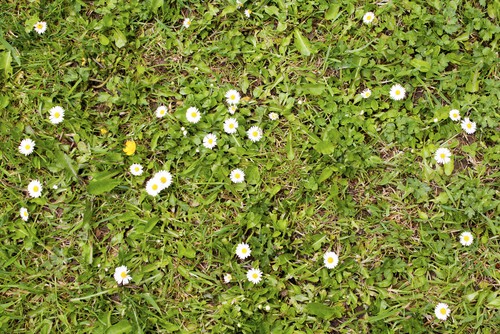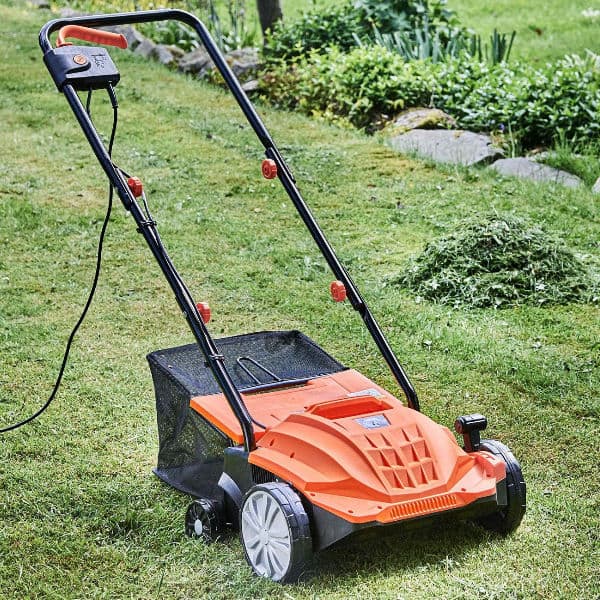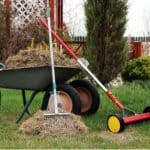Last updated on April 4th, 2022
Our site is reader supported, this means we may earn a small commission from Amazon and other affiliates when you buy through links on our site.
Lawn weeds are any invasive plant that’s competing with your lawn for space and nutrients. Plants like clovers, daisies, and dandelions are the most common, along with a long list of other weeds, preventing them is much better than trying to tackle a lawn full of weeds that hasn’t been treated in years.
Removing weeds promptly is the key to effective weed control, especially if you have a large area to cover. This might be something as simple as maintaining a good annual lawn care plan that includes applying a good lawn weed and feed. But how do you know if you really have a weed problem? Because some are very small and can blend in with the lawn.
Spotting the signs of weeds in your lawn

There a different signs that you can look out for. Your grass might start to take on a patchy appearance with uneven growth. There might be certain areas across your lawn that have a different texture than the rest. If you see flowers growing in your grass, that’s a pretty clear sign.
If certain patches remain green during a drought, it could be indicative of weeds that are performing better than the rest of your lawn, and of course, there are those large broadleaf weeds such as dandelions that are easy to spot.

If you notice the signs, it’s time to take action. Weeds are spread by seed or by creeping stems and if you have any area of grass that is sparse, they will quickly take over. This is one of the reasons you ideally want to scarify your lawn in autumn because the process often leaves bare patches on your lawn. You want to scarify when weed germination and growth are at their lowest.
You can learn more about scarifying a lawn to remove moss and weeds in this article by clicking here
It’s time to decide whether you want to use natural controls first, which basically means removing weeds by hand with a weed puller, or skipping this step and going straight ahead to the chemical weedkillers. This is often the best choice for smaller lawns with a large infestation of weeds. If you use good natural controls you might not need chemical controls. But some weeds are really hard to kill, so it never hurts to know all of your options.
Natural measures to control the weeds in your lawn
You can try non-chemical options to get rid of your weed problem before you turn to commercial weedkillers.
The first step in maintaining a good lawn and doing away with weeds is to give your lawn food, and to aerate and scarify your lawn every year. If you see rosette-type weeds, such as daisies or dandelions you can remove those using a hand fork or weeding tools. You can also rake over your lawn and mow it on a regular basis to discourage creeping weeds from getting too big. In the winter, apply some lime to your soil to deter winter-based weeds like field wood rush.
Our recommended lawn weedkillers
- Weed puller for weed control with a diameter of max. 4 cm, For a sustainable and environmentally friendly weed control, Ideal for the extraction of dandelions, thistles, nettles and other root crops in loose soils, vegetable garden or garden
- Traps the roots of the weeds between the claws of the weed puller (up to 10 cm underground), Extracts the plant along with its roots thanks to a patented mechanism of claws, With a little pressure on the handle the claws open and the weeds are released straight into a waiting wheelbarrow and off the lawn
- Work in an upright position: No strain on the muscles and shoulders thanks to the long handle, Practical non-slip handle for a better hold
- Handy foot pedal to push down the weed puller, Long life thanks to stainless steel claws and sturdy plastic handle (fiberglass), Easy to clean with water, Finnish design
- Contents: 1x Fiskars Xact Weed Puller, Length: 1 m, Diameter: 3 cm, Weight: 950 g, Material: Stainless Steel/Plastic, Colour: Black/Orange, 1020126
- Hammer finish epoxy coated head for improved resistance to rust, scratches, humidity and alkalis in the soil
- Weatherproofed (clear lacquered) ash wood handle for greater durability
- Used for removing daisies and weeds from lawns with minimal damage
- Grow Your Own 2022 Great British Growing Award Winners
- Durable leather strap
Using weedkillers to control the weeds in your lawn
You could do all of those natural controls and still have a problem with weeds now and again, in which case commercial weedkillers are best.
Lawn weedkillers can be used anywhere on your lawn where weeds have already established themselves. It’s important that you check the label before application to make sure that it will work on the type of weeds you see manifesting in your garden.
When you apply a lawn weedkiller, do so in the spring and the summer, because these are the two times of the year when the weeds will grow most voraciously. Always read the instructions before you start and follow them explicitly to get effective results.
Our top recommended lawn weedkillers
- Kills weeds not lawns
- Kills dandelions, daisies and clover
- No Glyphosate
- Apply through a sprayer or watering can
- Covers up to 667 m2
No products found.
- Kills weeds, not lawns.
- Kills dandelions, daisies and clover.
- Avoid mowing for 3 days before or after application.
Types of weedkillers to consider
Pay attention to the product you purchase and how it is applied. When you go to your local garden centre or the nursery (or even online) you can find lawn weedkillers that are granules you scatter on the surface. We strongly recommend, based on our own previous experiences, using a lawn spreader to apply because it can burn the lawn, leaving dead patches. Spot treatment sprays are ideal for targeting broadleaf weeds while weedkillers that you need to add to your watering can and then apply across the surface of larger areas of lawn are ideal. Pick the one that you like best and feel comfortable using.
How many treatments does it take to kill the weeds on a lawn?
Most weeds in your lawn can be effectively done away with following a single treatment, although you might find some sticklers that require two or three applications during an average of 5 weeks before they are completely gone. So if you have a few stragglers sticking around after your first application, don’t worry.
When comparing different products, if you see one that is a weedkiller and a moss killer, only use it if you have a problem with moss as well because you can just use weed and feed type products if not. The only exception to this is if you have a lawn that is prone to moss because it will help control the moss too.
New Lawns
If you have a new lawn, be advised that it can be severely damaged by weedkillers if you apply it to the lawn within six months of laying new turf. To that end, it’s important that you allow your new lawn to grow in for at least 6 months before you start tackling your weed problem. Weeds are not usually a problem in the beginning stages of a lawn establishing itself, however, if you do we recommend using manual weed tools.
Last update on 2025-07-14 / Affiliate links / Images from Amazon Product Advertising API






